Atkinson K. An Introduction to Numerical Analysis
Подождите немного. Документ загружается.

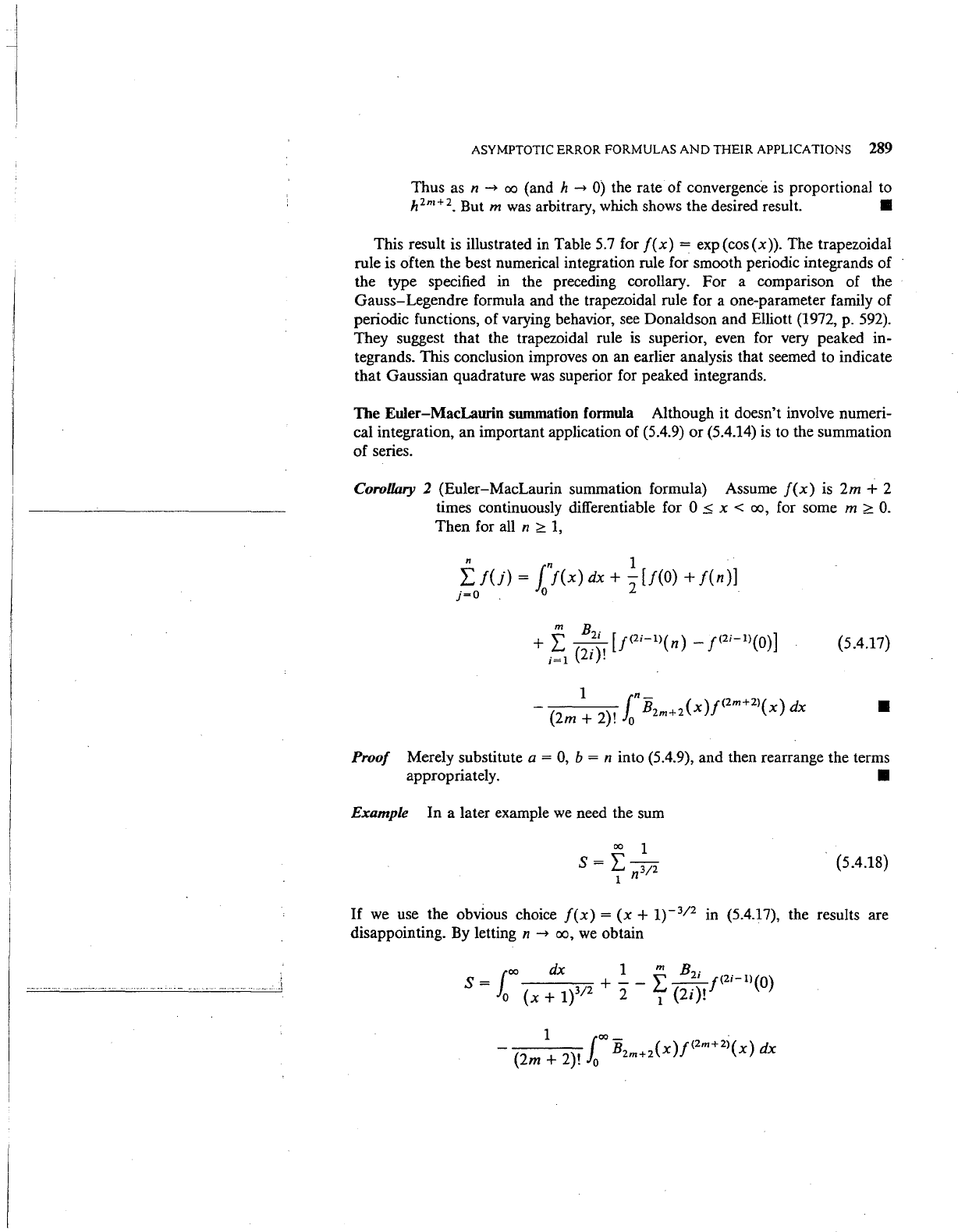
ASYMPTOTIC ERROR FORMULAS
AND
THEIR APPLICATIONS
289
Thus
as
n ~
oo
(and h ~
0)
the rate of convergence
is
proportional to
h
2
m+
2
•
But m
was
arbitrary, which shows the desired result. •
This result is illustrated
in
Table 5.7 for
f(x)
= exp(cos(x)). The trapezoidal
rule is often the best numerical integration rule for smooth periodic integrands of
the type specified in the preceding corollary. For a comparison of the
Gauss-
Legendre formula and the trapezoidal rule for a one-parameter family of
periodic functions, of varying behavior,
see
Donaldson and Elliott (1972,
p.
592).
They suggest that the trapezoidal rule
is
superior, even for very peaked in-
tegrands. This conclusion improves on an earlier analysis that seemed
to
indicate
that Gaussian quadrature
was
superior for peaked integrands.
The Euler-MacLaurin summation fonnula Although it doesn't involve numeri-
cal integration, an important application of
(5.4.9)
or
(5.4.14)
is
to the summation
of
series.
Corollary 2 (Euler-MacLaurin summation formula) Assume
f(x)
is
2m
+ 2
times continuously differentiable for
0 5 x <
oo,
for some m
~
0.
Then for all n
~
1,
n n 1
L
f(J)
= 1
f(x)
dx
+
2[/(0)
+
f(n)]
j=O
. 0
m
B.
+ L
-;[!<2i-l>(n)
_ t<2i-l>(o)]
i=l
(2z
).
1
1
n_
- B (x)J<
2
m+
2
>(x)
dx
(2m +
2)!
0
2m+2
(5.4.17)
•
Proof
Merely substitute a =
0,
b = n into (5.4.9), and then rearrange the terms
appropriately.
•
Example
In
a later example
we
need the sum
00
1
s =I:
3/2
1 n
(5.4.18)
If
we
use the obvious choice
f(x)
=
(x
+
1)-
3
1
2
in (5.4.17), the results are
disappointing.
By
letting n
-+
oo,
we
obtain
1
oo
dx
1 m
B2·
s-
+ I (2i-l) 0
- o (x +
1)
3
/
2
2-
~
(2i)!/
( )
1
oo_
·
- 1 B (x)J<
2
m+
2
>(x)
dx
(2m
+
2)!
0
2m+2
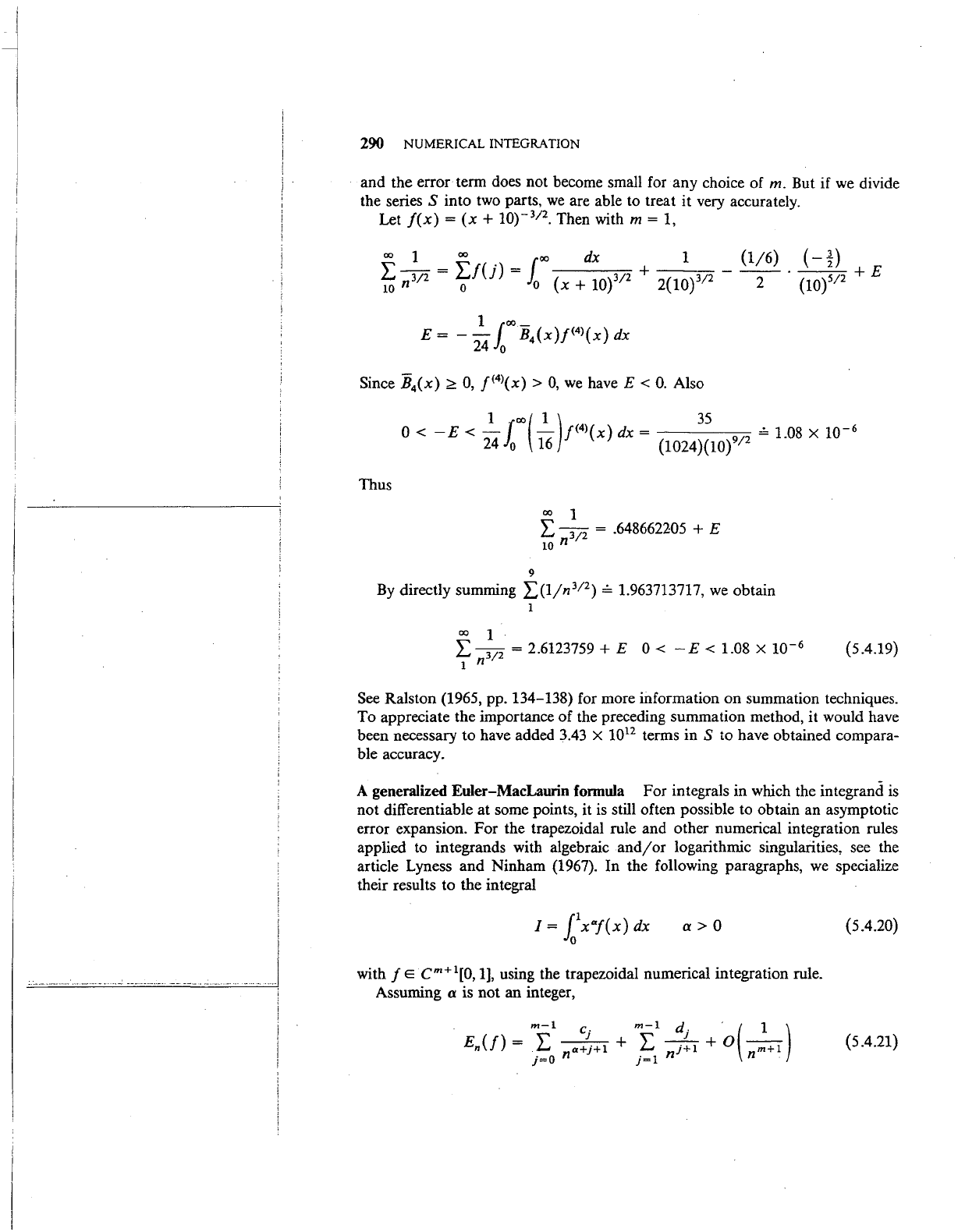
•
••••••••
u
••
•
•••
)
290
NUMERICAL INTEGRATION
and the error term does not become small for any choice of m. But if
we
divide
the series
S into
two
parts,
we
are able to treat it very accurately.
Let
j(x)
=
(x
+
10)-
3
1
2
•
Then with m = 1,
oo 1
00
.
1
oo
dx 1
(1/6)
(-
l)
"
"/(
) + z + E
'f;;
n
312
=
~
1
= o (x + 10)
312
2(10)
312
-
-2-.
(10)
512
Since B
4
(x)
:2:
0,
j<
4
>(x) >
0,
we
have E <
0.
Also
1
00(
1 )
35
0 <
-E
< -1 -
j<
4
>(x) dx =
='=
1.08 X
10-
6
24
0
16
(1024)(10)
912
Thus
9
00
1
L
3/2
= .648662205 + E
10 n
By
directly summing
L(ljn
3
1
2
)
= 1.963713717,
we
obtain
00
1
L
3/2
= 2.6123759 + E 0 <
-E
< 1.08 X
10-
6
1 n
(5.4.19)
See Ralston (1965, pp. 134-138) for more information on summation techniques.
To appreciate the importance
of
the preceding summation method, it would have
been necessary to have added
3.43
X
10
12
terms in S to have obtained compara-
ble accuracy.
A generalized Euler-MacLaurin
formula
For integrals in which the integrand
is
not differentiable at some points, it
is
still often possible to obtain an asymptotic
error expansion. For the trapezoidal rule and other numerical integration rules
applied to integrands with algebraic
andjor
logarithmic singularities, see the
article Lyness and Ninham (1967). In the following paragraphs,
we
specialize
their results to the integral
a>O
(5.4.20)
with j E
cm+
1
[0,
1],
using the trapezoidal numerical integration rule.
Assuming
a is not an integer,
(5.4.21)
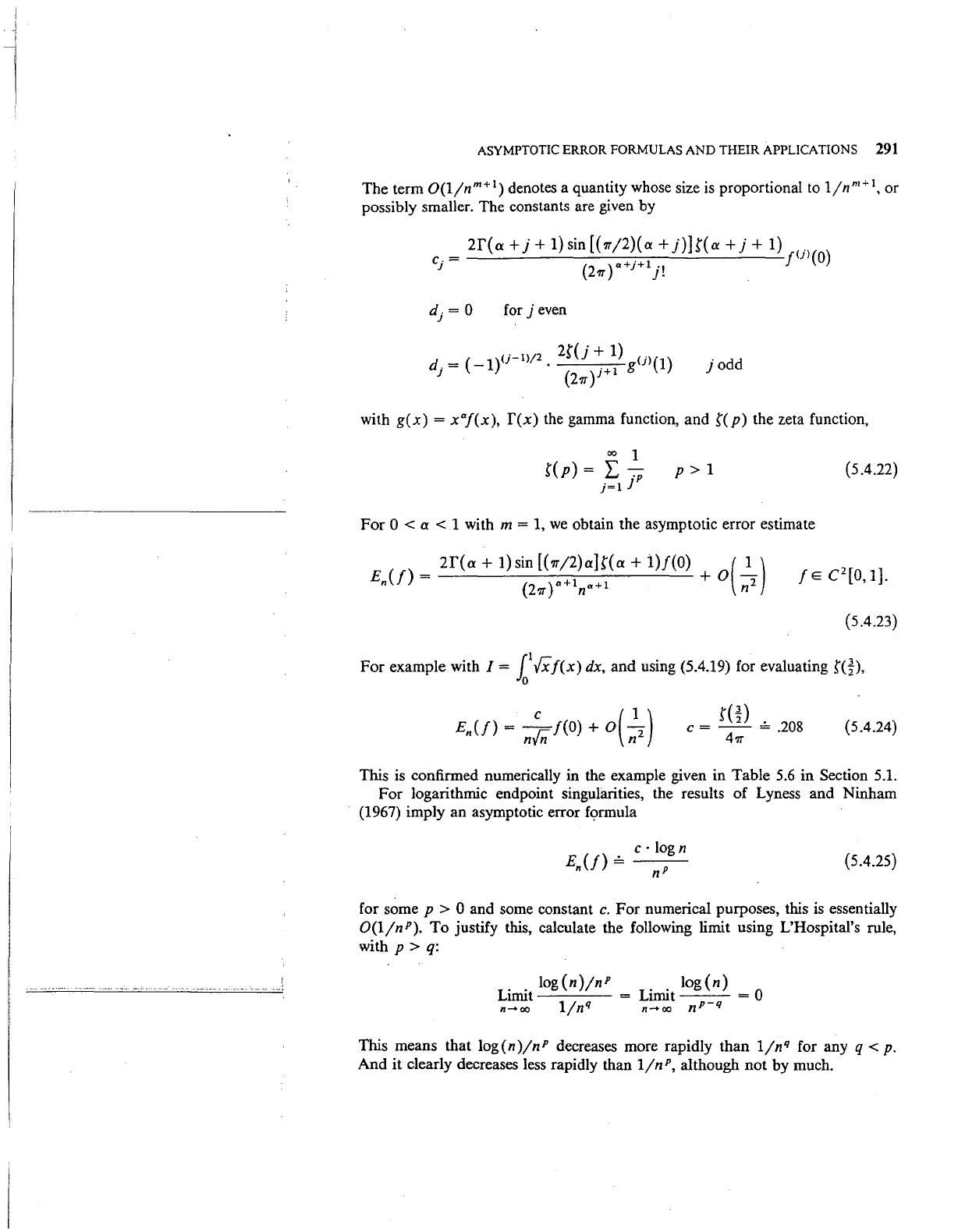
ASYMPTOTIC ERROR FORMULAS
AND
THEIR
APPLICATIONS
291
The term
0(1/nm+l)
denotes a quantity whose size is proportional to
1/nm+t,
or
possibly smaller. The constants are given by
2 r (a + j + 1) sin [ (
'1T
12)
(a
+
j)
H (a + j +
1)
.
= JU>(o)
cj
{2'1Tr+j+lj! .
d.=
0
J
for j even
2t(
"+
1)
d.=
(
-1)U-ll/
2
•
1
.
U>(1)
1·
odd
J
(2'1T);+l
g
with
g(x)
=
xaf(x),
f(x)
the gamma function,
and
t{p)
the zeta function,
00
1
t(
P)
=
L:
---:;
j=l}
p>1
(5.4.22)
For
0 < a < 1 with m = 1,
we
obtain the asymptotic error estimate
2f(
a+
1)
sin [( '1T/2)a]t( a +
i)/(0)
+
o(
n12)
En(!)=
(2'1T
t+lna+l
(5.4.23)
For
example with
I=
f5J(x)
dx,
and
using (5.4.19) for evaluating
t{f),
c =
t(t)
~
.208
4'1T
(5.4.24)
This is confirmed numerically in the example given
in
Table 5.6
in
Section 5.1.
For
logarithmic endpoint singularities, the results
of
Lyness
and
Ninham
(1967) imply
an
asymptotic error
f<;>rmula
(5.4.25)
for some p > 0 and some constant
c.
For
numerical purposes, this is essentially
0(1jnP).
To
justify this, calculate the following limit using L'Hospital's rule,
with p > q:
..
log(n)jnP
..
log(n)
Lmut = Lumt = 0
n--+oo
1/nq
n--+oo
np-q
This means that
log(n)jnP
decreases more rapidly
than
1/nq
for any q < p.
And
it
clearly decreases less rapidly than
1jnP,
although
not
by much.
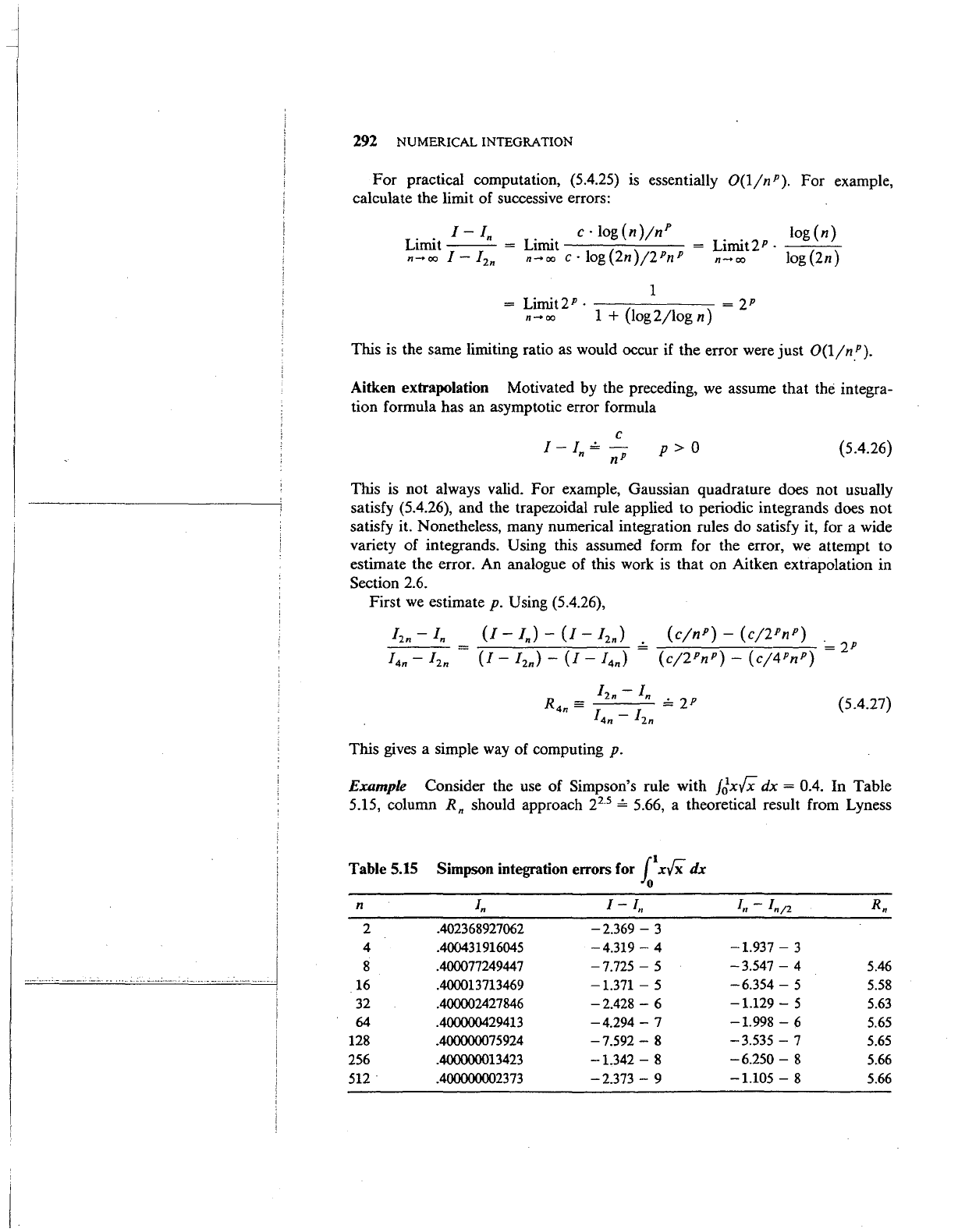
-
....
:-.:..
--
···-
~.:·
..
____
; ....... :
-·
········-
·····-·-·-···-···
292
NUMERICAL INTEGRATION
For practical computation, (5.4.25)
is
essentially
0(1jnP).
For example,
calculate the limit of successive errors:
I-1
Limit n
n-+oo
I-
/
2
n
. . c
·log(n)jnP
log(n}
Lnrut
= Limit2P ·
---
n-+oo
c
·log(2n)j2PnP
n-+oo
log(2n}
1
= Limit2P. =
2P
n-+oo
1+(log2jlogn)
This
is
the same limiting ratio
as
would occur if the error were just O(lfn.P).
Aitken extrapolation Motivated by the preceding,
we
assume that the integra-
tion formula has an asymptotic error formula
c
I-I=-
n
nP
p>O
{5.4.26)
This
is
not always valid. For example, Gaussian quadrature does not usually
satisfy (5.4.26), and the trapezoidal rule applied to periodic integrands does not
satisfy it. Nonetheless, many numerical integration rules do satisfy it, for a wide
variety of integrands.
Using this assumed form for the error,
we
attempt to
estimate the error. An analogue of this work
is
that on Aitken extrapolation in
Section 2.6.
First
we
estimate p. Using (5.4.26),
(I
- In) -
(I
- I 2n)
(I-
/2n) -
(I-
/4,)
This gives a simple
way
of computing p.
(5.4.27)
Example Consider the
use
of Simpson's rule with
/Jx/X
dx = 0.4. In Table
5.15, column Rn should approach
2
2
·
5
= 5.66, a theoretical result from Lyness
Table 5.15
Simpson integration errors for
1
1
xiX
dx
0
n
In
I-
I,
I,-
In/2
Rn
2 .402368927062
-2.369-
3
4
.400431916045
-4.319-
4
-1.937-
3
8
.400077249447
-7.725-
5
-3.547-
4
5.46
16
.400013713469
-1.371-
5
-6.354-
5
5.58
32 .400002427846
-2.428-
6
-1.129-
5
5.63
64 .400000429413
-4.294-
7
-1.998-
6
5.65
128
.400000075924
-7.592-8
-3.535-
7
5.65
256 .400000013423
-1.342-
8
-6.250-
8
5.66
512 .4000000023
73
-2.373-
9
-1.105-
8
5.66
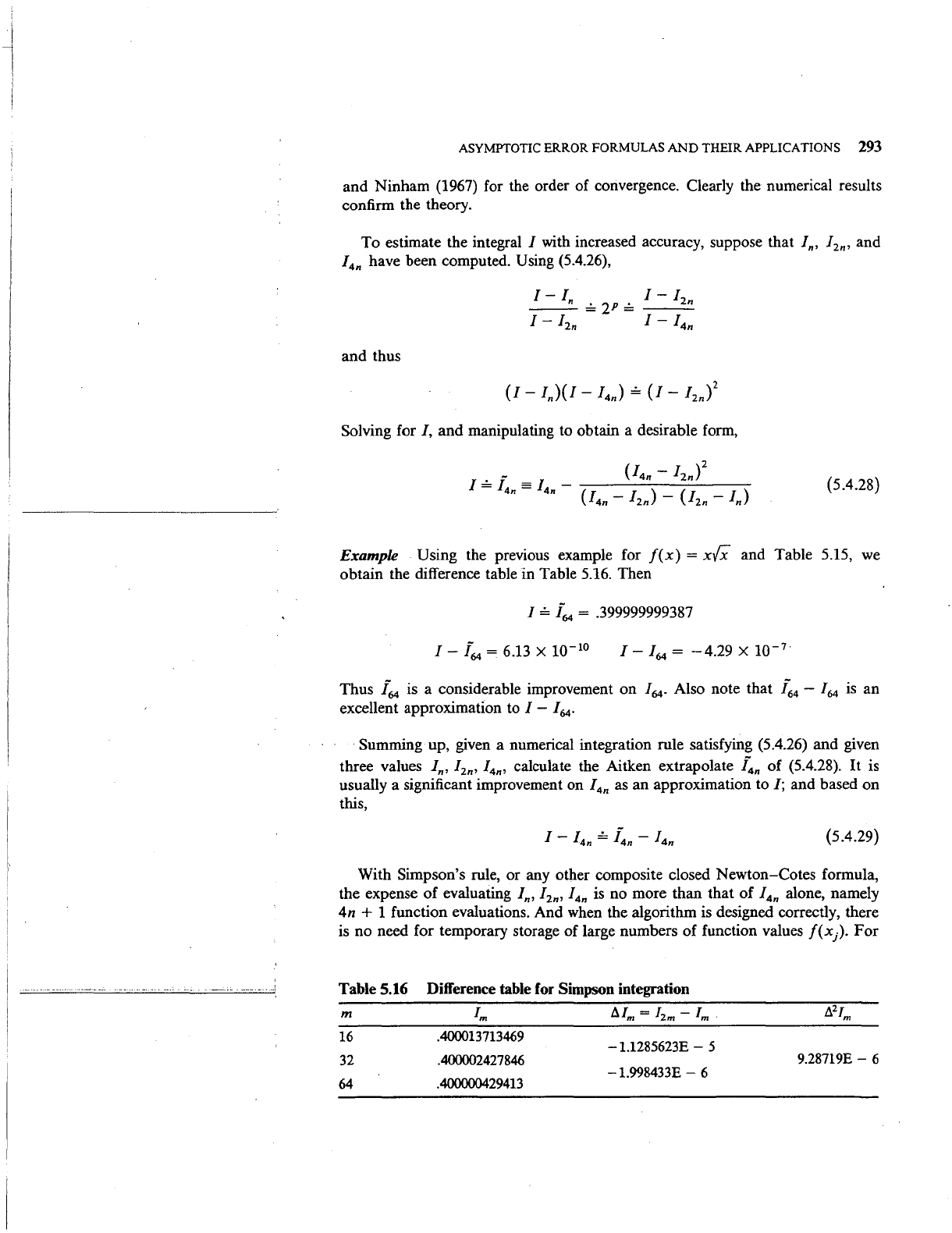
..
1
ASYMPTOTIC ERROR FORMULAS
AND
THEIR APPLICATIONS
293
and Ninham (1967) for the order of convergence. Clearly the numerical results
confirm the theory.
To estimate the integral
I with increased accuracy, suppose that In, I
2
n,
and
I
4
n have been computed. Using (5.4.26),
and thus
Solving for
I,
and manipulating to obtain a desirable form,
(5.4.28)
Example Using the previous example for
f(x)
=
xVx
and Table 5.15,
we
obtain the difference table in Table
5.16.
Then
I = i
64
= .399999999387
I-
f
64
=
6.13
X
10-
10
I-
I
64
=
-4.29
X
10-
7
Thus [
64
is a considerable improvement on I
64
•
Also note that
I:
4
- I
64
is
an
excellent approximation
to
I-
I
64
•
Summing up, given a numerical integration rule satisfying (5.4.26) and given
three values
In, I
2
n,
I
4
n,
calculate the Aitken extrapolate
~n
of (5.4.28).
It
is
usually a significant improvement on
I
4
n
as
an approximation to
I;
and based on
this,
(5.4.29)
With Simpson's rule, or any other composite closed Newton-Cotes formula,
the expense of evaluating
In, I
2
n,
I
4
n is no more than that of I
4
n alone, namely
4n
+ 1 function evaluations. And when the algorithm is designed correctly, there
is no need for temporary storage of large numbers of function values
f(x).
For
Table 5.16 Difference table for Simpson integration
m
/m
fl[m
=
[2m-
Jm
·
fl2Jm
16
.400013713469
-1.1285623E -
5
32 .400002427846
9.28719E-
6
64
.400000429413
-1.998433E - 6

294 NUMERICAL INTEGRATION
that
reason,
one
should never use Simpson's rule with
just
one value of the index
n.
With
no
extra expenditure
of
time, and with only a slightly more complicated
algorithm,
an
Aitken extrapolate and an error estimate can be produced.
Richardson
extrapolation
If
we
assume sufficient smoothness for the integrand
f(x)
in
our
integral
I(f),
then
we
can write the trapezoidal error
term
(5.4.9) as
.
d(O)
d(O)
d(O)
I-I
=-
2
-+-
4
-+···+~+F
n
n2
n4
n2m
n.m
(5.4.30)
where
In
denotes the trapezoidal rule, and
(
)
2m+2
b-a
h-
(x-a)
Fn,m
= (
2
m+
2
)!n2m+2l
B2m+2
-h-
J<Zm+Z>(x)
dx
(5.4.31)
Although the series dealt with are always finite and have an error term, we will
usually
not
directly concern ourselves with it.
.For
n even, ·
4d(O)
16d(O)
64d(O)
I-I
=-2-+
__
4_+
__
6_+···
n/2
n1 n4 n6
Multiply (5.4.30)
by
4
and
subtract from
it
(5.4.32):
-12d(O)
6Qd(O)
4( I - I ) -
(I
- I ) =
4
- -
6
- -
• • •
n
n/2
n4
n6
Define
1
I(l)
= _
[4I(0)
_
I(O)
]
n 3 n
n/1
2Qd(O)
6
~-···
n even n:::::2
and
/~
0
>
= Im.
We
call {
/~
1
>}
the Richardson extrapolate
of
{
/~
0
>
}.
The
sequence
/
(1) .
J(l)
J(l)
2 ' 4 ' 6 '
•••
is a new numerical integration rule.
For
the error,
d(l)
d(l)
I -
J<l>
=
_4_
+
_6_
+
n
n4
n6
d
(l)
=
-4d(O)
d(l)
=
-2Qd(O)
4 4 ' 6 6 '
•••
(5.4.32)
(5.4.33)
(5.4.34)
(5.4.35)

.i
ASYMPTOTIC ERROR FORMULAS AND
THEIR
APPLICATIONS 295
To
see the explicit formula for
I~
1
>,
let h =
(b-
a)jn
and x
1
=a+
jh for
j =
0,
1,
...
, n. Then using (5.4.33) and the definition of the trapezoidal rule,
4h [ 1 1 ]
I(l) = - - { + f + f + f +
...
+/,
+
-/,
n
3
2
JO
l 2 3 n-1
2
n
h .
IP)
= J[/o +
4/l
+ 2/2 +
4/3
+ · · ·
+2fn-2
+ 4/n-1 +
fn]
(5.4.36)
which
is
Simpson's rule with n subdivisions.
For
the error, using (5.4.35) and
(5.4.31),.
h4 h6
I_
I(1J = _
-[J(3l(b)
_ J(3l(a)] +
---(J<5l(b)
_
J<S>(a)]
+
...
n
180
1512
(5.4.37)
This means that the work on the Euler-MacLaurin formula transfers to Simpson's
rule by means of some simple algebraic manipulations. We omit any numerical
examples since they would just be Simpson's rule, due to (5.4.36).
The
preceding argument, which led to
I~
1
>,
can
be
continued to produce other
new formulas.
As
before, if n is a multiple
of
4,
then
16d(l)
64d(
1
)
I-
I<I>
=
__
4_
+
__
6_
+
...
n/2
n4
n6
.
-48d(
1
)
16(I-
I<
1
>)-
(I-
I<
1
>)
=
6
+ · · ·
n
n/2
n6
I=
16J(l) - J(l) 48d(l) .
n
n/2
___
6_
+
...
15
15n
6
(5.4.38)
Then
d(2)
d(2)
(
2)
6 8
[-[
=-+-+···
n
n6
n8
(5.4.39)
with
16I(1) - J(l)
J(2)
= n
n/2
n
15
n~4
(5.4.40)
and
n divisible by
4.
We call
{1~
2
>}
the Richardson extrapolate of
{1~
1
>
}.
If
we
derive the actual integration weights
of
Jp>,
in analogy with (5.4.36),
we
will find
that
Jp>
is simply the composite Boole's rule.
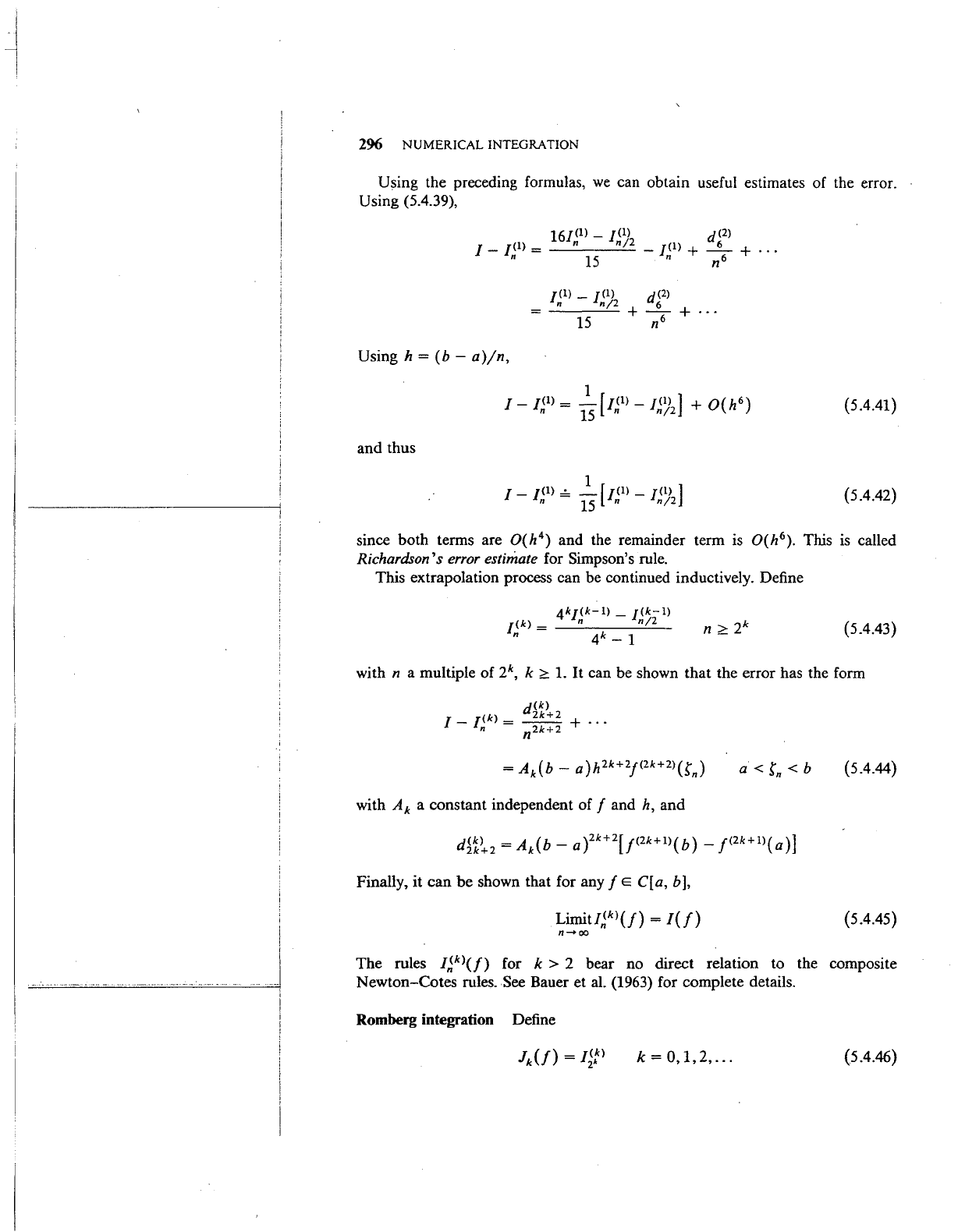
296
NUMERICAL INTEGRATION
Using the preceding formulas,
we
can obtain useful estimates of the error.
Using (5.4.39),
16I(l) - I(l)
d(2)
I - IP) = n
nj2
- I(l) +
_6_
+ • . •
15
" n
6
I(l) - I(l)
d(2)
n
n/2
+
_6_
+
...
15
n
6
Using h =
(b-
a)jn,
1
I_
I<I>
=
-(I<I>
_
I<I>]
+
O(h6)
n
15
n
n/2
(5.4.41)
and thus
1
I_
I<Il
~
_
(I<I>
_
I<I>
]
n
15
n
n/2
(5.4.42)
since both terms are
O(h
4
)
and the remainder term
is
O(h
6
).
This
is
called
Richardson's error estimate for Simpson's rule.
This extrapolation process can be continued inductively. Define
4ki(k-1)-
J(k-1)
I(k)
= n
nj2
n
4k-
1
(5.4.43)
with
n a multiple of
2k,
k
~
1.
It
can be shown that the error has the form
d(k)
(
k)
2k+2
I-I
=--+···
n
n2k+2
(5.4.44)
with Ak a constant independent
off
and
h,
and
Finally, it can
be
shown that for any f E
C[a,
b],
Limitl~k>(J)
=I(!)
(5.4.45)
n-+oo
The rules
I~k>(J)
for k > 2 bear no direct relation to the composite
Newton-Cotes rules. See Bauer et
al.
(1963) for complete details.
Romberg
integration Define
k =
0,1,2,
...
(5.4.46)
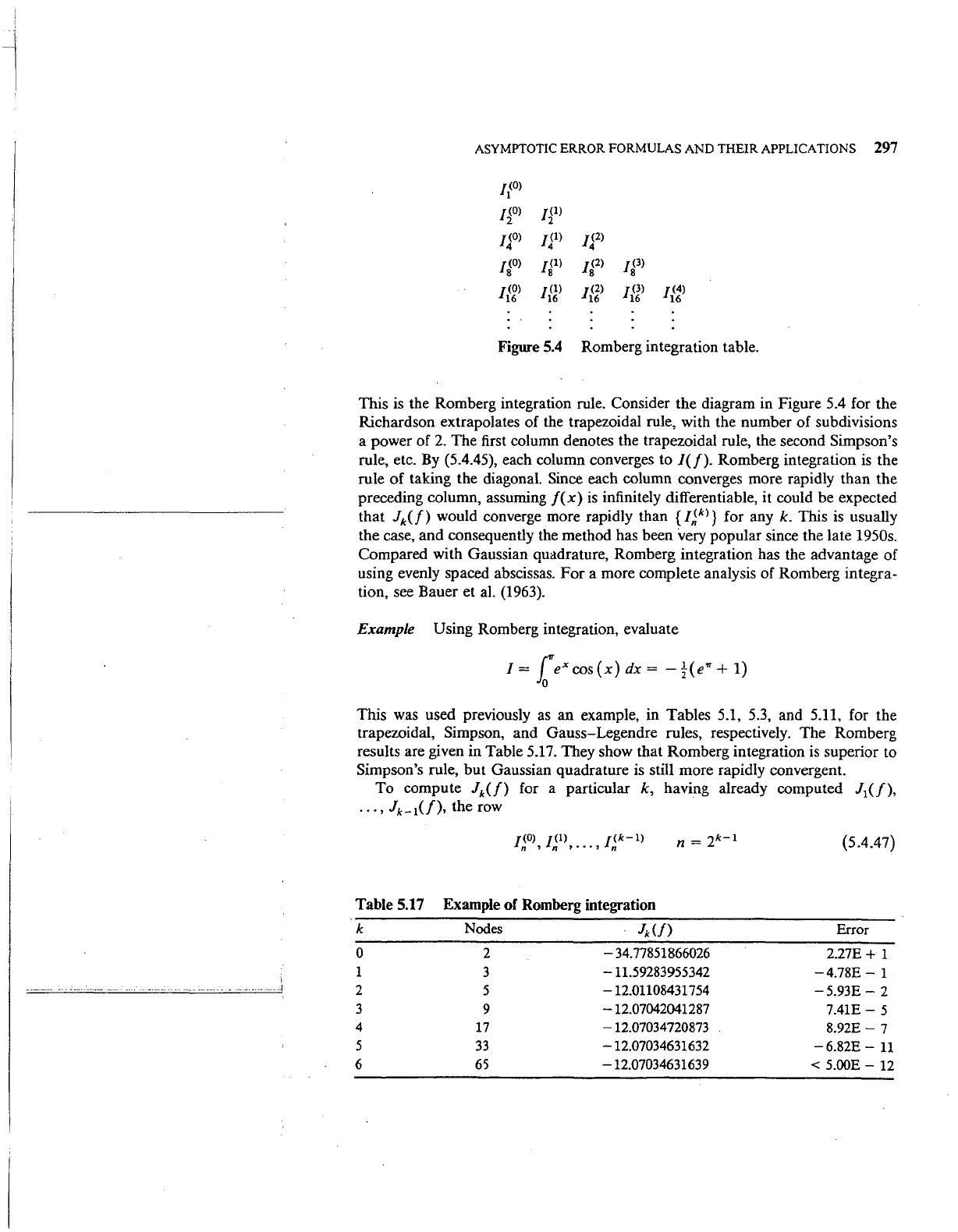
ASYMPTOTIC ERROR FORMULAS AND
THEIR
APPLICATIONS 297
J(O)
I
f(O)
2
J(1)
2
J(O)
4
Jjl>
/(2)
4
J(O)
8
J(1)
8
/(2)
8
J(3)
8
f(O)
16
J(1)
16
/(2)
16
J(3)
16
J(4)
16
Figure
5.4
Romberg integration table.
This is the Romberg integration rule. Consider the diagram in Figure 5.4 for the
Richardson extrapolates of the trapezoidal rule, with the number of subdivisions
a power of
2.
The first column denotes the trapezoidal rule, the second Simpson's
rule, etc.
By
(5.4.45), each column converges to
/(f).
Romberg integration
is
the
rule
of
taking the diagonal. Since each column converges more rapidly than the
preceding column, assuming
f(x)
is
infinitely differentiable, it could be expected
that
Jk(f)
would converge more rapidly than
{I~kl}
for any k. This
is
usually
the case, and consequently the method has been
very popular since the late 1950s.
Compared with Gaussian quadrature, Romberg integration has the advantage of
using evenly spaced abscissas. For a more complete analysis of Romberg integra-
tion, see Bauer et al. (1963).
Example Using Romberg integration, evaluate
This
was
used previously
as
an example, in Tables 5.1,
5.3,
and 5.11, for the
trapezoidal, Simpson, and Gauss-Legendre rules, respectively. The Romberg
results are given in Table
5.17.
They show that Romberg integration
is
superior to
Simpson's rule,
but
Gaussian quadrature
is
still more rapidly convergent.
To compute
Jk(f)
for a particular k, having already computed J
1
(f),
...
, Jk_
1
(f),
the row
Table 5.17 Example of Romberg integration
k Nodes
Jk
(/)
0
1
2
3
4
5
6
2
3
5
9
17
33
6S
-34.77851866026
-11.59283955342
-12.01108431754
-12.07042041287
-12.07034720873
-12.07034631632
-12.07034631639
{5.4.47)
Error
2.27E + 1
-4.78E-
1
-5.93E-
2
7.41E-
5
8.92E-
7
-6.82E-
11
<
5.00E-
12
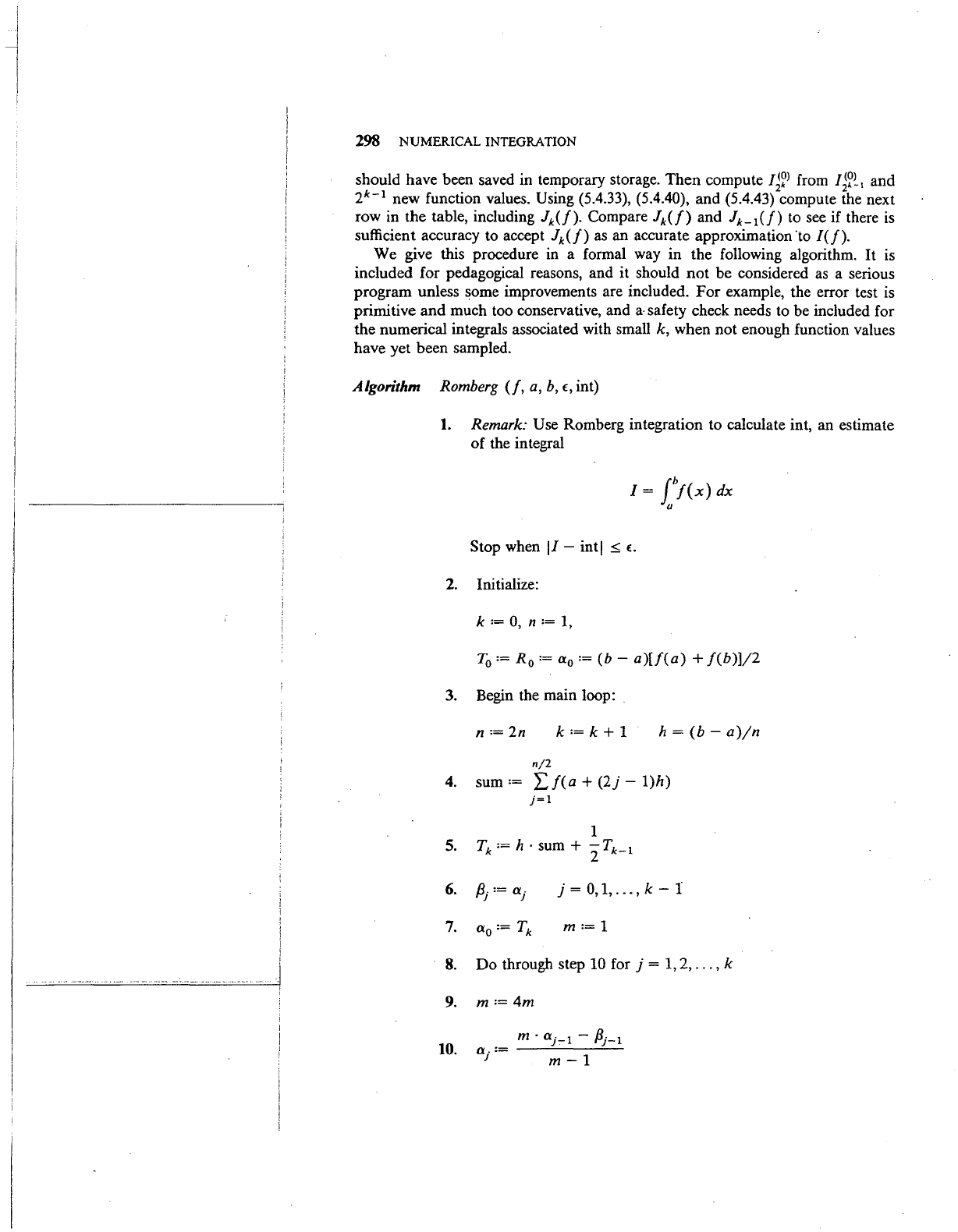
298 NUMERICAL INTEGRATION
should have been saved in temporary storage. Then
compute/~~)
from
Ii?~~
and
2k-
1
new function values. Using (5.4.33), (5.4.40), and (5.4.43) compute the next
row in the table, including
Jk(f).
Compare
Jk(f)
and Jk_
1
(f)
to see if there
is
sufficient accuracy to accept
Jk(f)
as
an accurate approximation ·to
/(/).
We give this procedure
in
a formal way in the following algorithm. It
is
included for pedagogical reasons, and it should
not
be considered
as
a serious
program unless some improvements are included.
For
example, the error test is
primitive and much too conservative, and
a·
safety check needs to be included for
the numerical integrals associated with small
k, when not enough function values
have yet been sampled.
Algorithm Romberg
(f,
a, b,
£,
int)
1.
Remark: Use Romberg integration to calculate int, an estimate
of the integral
Stop when
I/-
inti
~
£.
2.
Initialize:
k
:=
0, n
:=
1,
T
0
:= R
0
:= a
0
:=
(b-
a)[f(a)
+
/(b)]/2
3. Begin the main loop:
n
:=
2n
k
:=
k + 1
h
=
(b-
a)jn
n/2
4.
sum:=
L
f(a
+
(2}-
1)h)
j=1
1
5.
Tk
:= h
·sum+
2Tk_
1
6.
f3j
:=
aj
j = 0, 1,
...
, k - l
8.
Do
through step
10
for j = 1, 2,
...
, k
9. m
:=
4m
10.
m.
aj-1-
f3j-1
aj
:=
m-
1
